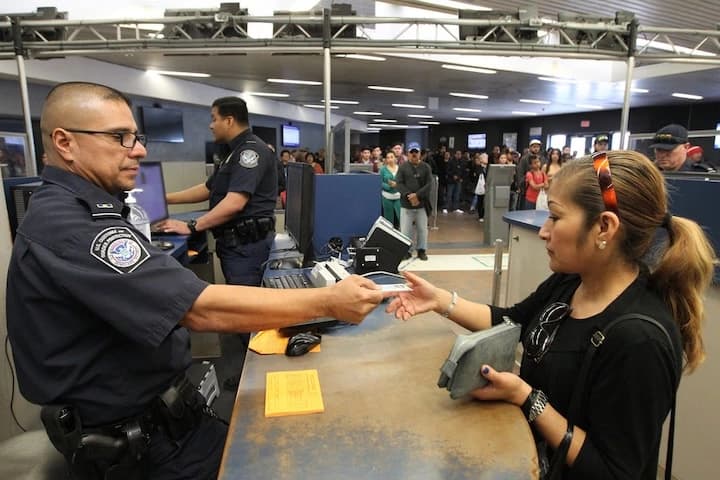Best Guide: Port of Entry Process for International Students in the USA 2025

Key Highlights
- This blog provides a complete step-by-step guide to help international students navigate the US port of entry process smoothly.
- You will find an essential checklist of documents to carry to avoid delays or complications at the airport.
- The blog explains common scenarios, including good and bad situations, and offers practical tips to handle them with confidence.
- Discover 10 common questions asked by officers at the port of entry with sample answers and funny, practical tips.
- Get clear and concise answers to frequently asked questions about entering the USA with a student visa.
Congratulations! You’ve secured your US student visa, and your flight to the land of opportunities is booked. But hold on—before you start dreaming about college life, there’s one final hurdle to cross: the US port of entry. This is where the real journey begins, and as exciting as it is, it can feel a bit overwhelming. Don’t worry; this guide has got your back!
In this post, we’ll break down everything you need to know about navigating the US port of entry process, from preparation to what to expect, potential scenarios (both good and bad), common questions officers may ask, and some hilarious yet practical tips to stay cool.
What to Expect at the Port of Entry
Picture this: you’ve just landed at a bustling US airport after a long flight. As an international student, the port of entry (POE) is your gateway into the United States. Here’s what typically happens:
1. Immigration Check
After deplaning, you’ll follow signs to the CBP (Customs and Border Protection) area. You’ll join a line for international visitors, where an officer will verify your documents and ask questions about your purpose of travel.
2. Customs Declaration
Once the immigration check is done, you’ll proceed to customs to declare any items you’re carrying.
3. Baggage Collection
Pick up your luggage and, if needed, recheck it for connecting flights.
4. Secondary Inspection (Maybe)
If anything seems unclear during the immigration check, you might be sent to a secondary inspection area for further questioning. This is rare but nothing to panic about.
How to Prepare for the US Port of Entry
1. Documents to Carry
Make sure your travel folder is ready with these essentials:
- Passport with US Student Visa: The star of the show—don’t even think about losing this!
- I-20 Form: This proves your student status.
- SEVIS Fee Receipt: Evidence you’ve paid your dues.
- University Admission Letter: Shows you’re legit.
- Financial Documents: Proof you can support yourself, like bank statements or sponsorship letters.
- Travel Itinerary: Flight details and address of your destination.
- Emergency Contact Info: Keep numbers of your school and family handy.
2. Tips to Stay Ready
- Practice your answers: Officers ask basic questions; keep your responses clear and honest.
- Dress appropriately: First impressions matter, so ditch the pajamas!
- Be polite: A smile goes a long way.
Scenarios You Might Encounter at the US Port of Entry
The Good
- Quick and Easy: You breeze through immigration because you’re well-prepared, confident, and polite.
- Friendly Officer: The officer asks simple questions and welcomes you with a smile.
The Bad
- Forgot Documents: You left your I-20 at home—oops!
- Unclear Answers: You hesitate when asked about your university, raising unnecessary red flags.
- Secondary Inspection: Your documents are fine, but they still need more info to clear you.
Remember, even “bad” scenarios are manageable if you stay calm. The officers are there to ensure everyone follows the rules, not to scare you.
How to Navigate Bad Scenarios at the Port of Entry in the USA
Even if you find yourself in one of these “bad” scenarios, don’t panic. Every situation has a solution, and staying calm is the first step toward resolving it. Here’s how you can handle these scenarios effectively:
1. Forgot Documents: You Left Your I-20 at Home—Oops!
If you realize you’ve forgotten your I-20 form:
- Immediate Action: Politely explain to the officer that you accidentally left it behind. Show any digital copies (if available) on your phone or email to prove your student status.
- Backup Plan: Ask your university’s Designated School Official (DSO) to send an electronic copy or fax the I-20 directly to the Customs and Border Protection (CBP) office at the airport.
- Tip for Prevention: Before traveling, double-check your documents and keep physical copies in your carry-on. Create a checklist to ensure nothing is missed.
2. Unclear Answers: Hesitating When Asked About Your University
If you stumble over a question or seem unsure:
- Immediate Action: Apologize and clarify your response. For example, “Sorry, I was just nervous. I am attending [University Name and my major is [Program Name].”
- How to Fix It: Provide any supporting documents, like your university acceptance letter, to back up your answer.
- Tip for Prevention: Practice answering common port-of-entry questions before your trip to avoid hesitation. Confidence is key!
3. Secondary Inspection: Your Documents Are Fine, But More Info Is Needed
Being sent to secondary inspection can feel intimidating, but it’s not a sign of doom:
- What Happens: Officers will take you to a separate area to review your documents more thoroughly or ask additional questions.
- How to Handle It:
- Stay calm and polite. This is a routine procedure.
- Answer questions clearly and consistently.
- Provide any requested documents promptly.
- If the officers need additional details, contact your university DSO for assistance. They can confirm your student status directly with the CBP.
Tip for Prevention: Ensure all your documents are complete and accurate before traveling. Double-check your SEVIS status, as this is often reviewed during secondary inspection.
10 Common Questions Asked at the Port of Entry (With Sample Answers and Tips!)
-
Why are you visiting the USA?
Sample Answer: “I’m here to study at [Your University Name] under an F-1 student visa.”
Tip: Don’t say, “To become the next Elon Musk”—yet.
-
Where will you be staying?
Sample Answer: “I’ll be staying at the university dorms at [Address].”
Tip: Know your address—it’s not a geography test, but close enough!
-
What will you be studying?
Sample Answer: “I’ll be pursuing a Master’s in Computer Science.”
Tip: Don’t say, “Just winging it”—they won’t find it funny.
-
How are you funding your education?
Sample Answer: “My family is sponsoring me, and here are my bank statements.”
Tip: Keep it simple—nobody wants to hear your family tree.
-
Do you have family or friends in the US?
Sample Answer: “Yes, I have a cousin in Texas, but I’ll primarily stay on campus.”
Tip: Honesty is key—don’t list your entire Facebook friends list.
-
What is your university’s name and address?
Sample Answer: “[University Name], located at [Address].”
Tip: Write it down if you’re worried about blanking out.
-
Have you traveled to the US before?
Sample Answer: “No, this is my first time, and I’m excited!”
Tip: Enthusiasm wins points, but don’t overdo it.
-
When do your classes begin?
Sample Answer: “My classes start on [Date], and I’m arriving early to settle in.”
Tip: No need to say, “I’ll be fashionably late”—they won’t appreciate it.
-
What’s in your luggage?
Sample Answer: “Clothes, books, and essentials for student life.”
Tip: Avoid mentioning “a year’s supply of snacks”—even if it’s true.
-
What will you do after graduation?
Sample Answer: “I plan to gain experience and then return to my home country.”
Tip: No need to declare your future as “undecided.”
Final Words
The US port of entry process might seem intimidating, but with preparation, it’s a walk in the park—or, well, an airport terminal. Keep your documents handy, answer questions confidently, and remember: you’ve made it this far! This guide should help you smoothly navigate the experience and start your journey as an international student on the right foot.
FAQs About the US Port of Entry Process
1. What if I lose my I-20 form before the trip?
Contact your university immediately to get a replacement or a digital copy sent to you.
2. How early should I arrive at the airport for my flight?
At least 3 hours before an international flight to ensure smooth check-in.
3. Can I bring food to the US?
Yes, but avoid fresh produce, meat, or dairy—it’s better to read customs guidelines beforehand.
4. What happens in secondary inspection?
It’s a detailed check of your documents or answers. Stay calm and provide accurate information.
5. Can I work during my studies?
Yes, but only on-campus jobs are allowed for international students on F-1 visas.
6. What if I don’t understand the officer’s question?
Politely ask them to repeat or clarify. It’s better than guessing!
7. What if my flight is delayed and I arrive late?
Inform your university and the CBP officer. They understand travel hiccups happen.
8. Can I use my phone during the interview?
No, it’s considered rude. Keep it tucked away.
9. What’s the Customs Declaration Form?
It’s a form you fill out to declare what you’re bringing into the US, like cash over $10,000 or specific goods.
10. What if I’m nervous?
Take a deep breath. The officers are just doing their job, and being well-prepared will ease the process.
Have Questions About This Topic?
Join our community to get personalized advice and share experiences with others going through similar visa processes.




